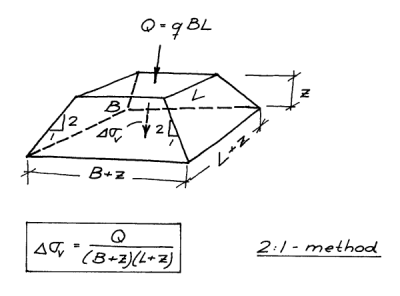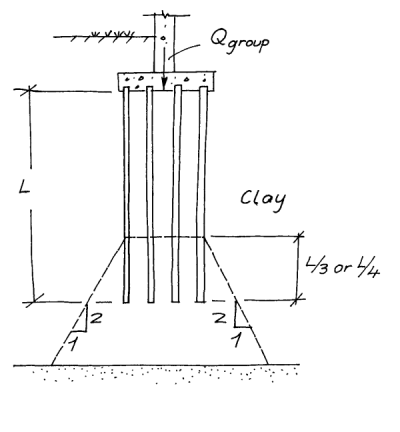
Readers of my post Analytical Boussinesq Solutions for Strip, Square and Rectangular Loads and those related to it know that the math related to these methods can get complicated, and in any case the idea of a “purely elastic” soil response to load is purely theoretical. So is there a simpler way? The most common simplification used is the 2:1 Method, shown at the right.
The method basically assumes the following:
- Uniformly loaded foundation
- Only stresses of interest are under the centroid of the foundation, as shown, and only vertical stresses are considered
- Stresses decrease as if there is a truncated pyramid below the foundation with a slope of 1H:2V.
As shown, to determine the additional vertical stress at a distance
below the centre of the foundation, the equation for a rectangular foundation of width B and length L (can be interchanged, but conventionally B is the smaller of the two) for a load Q on the surface is given by the equation
(1)
If the equation is written in terms of the unit load q, it becomes
(2)
Obviously for square foundations but the solution is the same.
As an example, let us consider a foundation where . By substitution into Equation (1),
. If we compute the unit load to be
, substitution into Equation (2) yields the same result.
Although it is possible to apply this method to circular foundations, it is just as easy to use Boussinesq theory under the centre of the foundation. The equation for a circle of radius and all other variables the same is
(3)

The 2:1 method is the only method taught in Soils in Construction. It is generally used with shallow foundations, but can also be applied to pile groups in clay, as shown at the right. It’s simplicity and reasonable accuracy has brought it acceptance, and further information on it can be found in the Soils and Foundations Reference Manual. The concept has also been applied to pile toes, and you can see this in STADYN Wave Equation Program 10: Effective Hyperbolic Strain-Softened Shear Modulus for Driven Piles in Clay.
